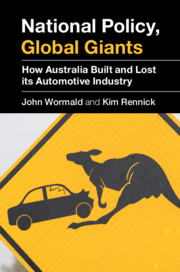Book contents
- National Policy, Global Giants: how Australia built and lost its Automotive Industry
- National Policy, Global Giants: how Australia built and lost its Automotive Industry
- Copyright page
- Contents
- Figures
- Acknowledgements
- Abbreviations
- Introduction
- 1 The Triumph of the Automobile: and Its Incipient Decline
- 2 From Revolution to Revolution: a Changing Automotive Industry
- 3 The Vehicle Manufacturers: a Controlling Global Semi-oligarchy
- 4 A Highly Disciplined Global Partnership: the Components Suppliers
- 5 Tense Relationships: the Automotive Industry and Government
- 6 Enthusiastic Adopters: Growth and Change in the Australian Car Market
- 7 The End of a Life cycle the Rise and Fall of the Australian Light Vehicle Industry
- 8 Distant Children: Australian Vehicle Manufacturers and Their Foreign Parents
- 9 The Australian Component Suppliers: Doomed by being so Sub-scale
- 10 From Consistency to Contradiction: Australian Government Automotive Policy
- 11 Government Support Policy and Sectoral Analysis: Lessons Learned
- Index
1 - The Triumph of the Automobile: and Its Incipient Decline
Published online by Cambridge University Press: 14 December 2019
- National Policy, Global Giants: how Australia built and lost its Automotive Industry
- National Policy, Global Giants: how Australia built and lost its Automotive Industry
- Copyright page
- Contents
- Figures
- Acknowledgements
- Abbreviations
- Introduction
- 1 The Triumph of the Automobile: and Its Incipient Decline
- 2 From Revolution to Revolution: a Changing Automotive Industry
- 3 The Vehicle Manufacturers: a Controlling Global Semi-oligarchy
- 4 A Highly Disciplined Global Partnership: the Components Suppliers
- 5 Tense Relationships: the Automotive Industry and Government
- 6 Enthusiastic Adopters: Growth and Change in the Australian Car Market
- 7 The End of a Life cycle the Rise and Fall of the Australian Light Vehicle Industry
- 8 Distant Children: Australian Vehicle Manufacturers and Their Foreign Parents
- 9 The Australian Component Suppliers: Doomed by being so Sub-scale
- 10 From Consistency to Contradiction: Australian Government Automotive Policy
- 11 Government Support Policy and Sectoral Analysis: Lessons Learned
- Index
Summary
Describes the development of the automobile as a product, from the first simple horseless carriages to today’s highly sophisticated vehicles with a large dose of electronic controls – and how, in its present form, it is threatened by environmental pressures and the development of new technologies. We present the spectacular growth of demand, the saturation of developed country markets, the emergence of China, and the persistence of regional particularities.
- Type
- Chapter
- Information
- National Policy, Global GiantsHow Australia Built and Lost its Automotive Industry, pp. 7 - 38Publisher: Cambridge University PressPrint publication year: 2020

